The Climate Change Act 2008 compels the UK to reach net zero emissions by 2050 and this paper looks at where the public sector can play a role in this journey. We look at governments’ contribution to CO2 emissions and what policies are in place for government entities to tackle these. We also look at the way money is allocated within government and how green targets could be interwoven into the budgeting process.
How much does the public sector contribute to CO2?
This compares to 112.5 MtCO2 for the transport sector (34% of total emissions),
61.9 MtCO2 for business sector (18.7% of all carbon dioxide emissions) and 56.4 MtCO2 for the residential sector (17% of all emissions). Energy and other sectors make up the rest.
Climate actions for the public sector: operational vs policy driven outcomes

Who has responsibility/oversight of climate policy aimed at the public sector?
DESNZ, Department for Energy and Net Zero, has a priority outcome to reduce energy demand by 15% according to gov.uk which specifically includes the public sector. No further details are available such as timelines. However, the 2021 Heat and Buildings Strategy issued by BEIS aimed to reduce direct emissions from public sector buildings by 75% against a 2017 baseline by end of 2037.
Government planning and performance framework
This framework explains how the government sets priorities, plans activities, allocates money and monitors progress and performance using a collective set of processes
- Spending review – multi-year spending envelope for each department
- Supply estimates – process whereby Parliament agrees departmental spend
- Outcome delivery plans – capture priority outcomes for each department
- Budgets – annual review spending in light of economic developments
- Annual reporting – performance reporting including budget vs spend
Current sustainability reporting frameworks
Phase III – Strategy including scenario and impact analysis from 2025-26.
Greening Government Commitments (GGC): Owned by DEFRA, the GGC set out the actions entities within scope will take to reduce their impacts on the environment including CO2, water and waste reduction. Departments report their progress every quarter with the results published in GGCs annual report each financial year.
How much does the public sector contribute to CO2?
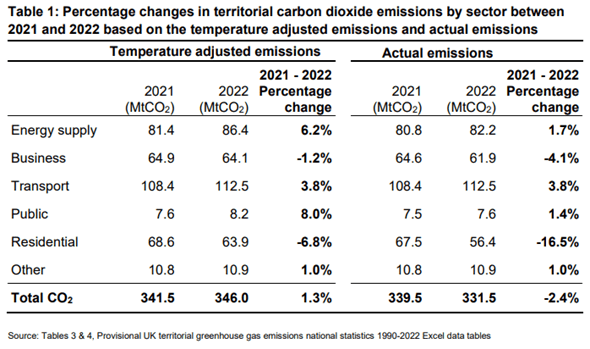
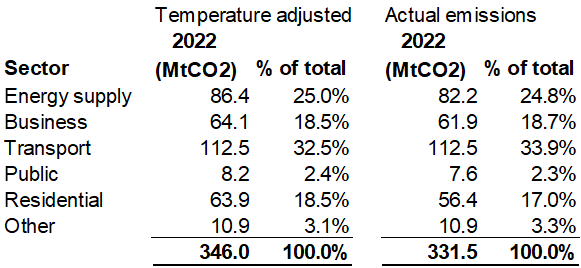
(Note that transport relates primarily to vehicles on the road)
Commitments made so far:
- As per BEIS’s 2021 Heat and Buildings Strategy, the target is to reduce direct emissions from public sector buildings by 75% against a 2017 baseline by the end of 2037 (p24).
- Schools and higher education account for 36% of total public sector building emissions. Department for Education will work with science-based targets from 2025, with the aim of reducing emissions by 50% by end of carbon budget 5 (2032) and 75% by end of carbon budget 6 (2037).
- Funding for emissions reduction in public sector buildings is via the Public Sector Decarbonisation Scheme, managed by Salix Finances on behalf of DESNZ. Committed finance so far:
o Phase I - £1bn in grants over financial years 2020-2021 and 2021-22 as part of Chancellors Plan for Jobs 2020.
o Phase II - £75m for the financial year 2021-22
o Phase III - £1.425bn for financial years 2022-23 and 2025-26
Climate actions for the public sector
When it comes to climate change, government is different to the private sector in one major way, and that is through its ability to tax, regulate and legislate.
Climate risks, opportunities and impacts on the environment, society and the economy will vary in context from one type of government entity to another. Severe weather events may have relatively limited impact on public sector operations compared with the impact on the wider economy and provision of services as demonstrated in the table below.
Examples of extreme weather events and how these impact government operations, services being provided and policies to mitigate
| Event |
Impact on |
Impact on Services |
Policy mitigation |
| Extreme weather – heat |
Reduced productivity |
Infrastructure damage eg railways; increased hospital admissions; school closures |
Increase spend on adaptation eg cooling systems in hospitals and schools, more green spaces |
| Extreme weather – flood/storm |
Travel disruption, damage to buildings |
Infrastructure damage eg power supply; increased demand on emergency services |
Insurer of last resort, water management and flood defences |
| Extreme weather – drought |
Restricted water usage |
Risk to public water supply, green spaces decline |
Water management plans, |
Interconnection between economy, society and nature – the role of government
The public sector plays a vital role in growing the economy, supporting society whilst protecting our environment. There will be competing demands to manage since economic growth is currently likely to be at the detriment of our environment but without economic growth, society will remain poorer.
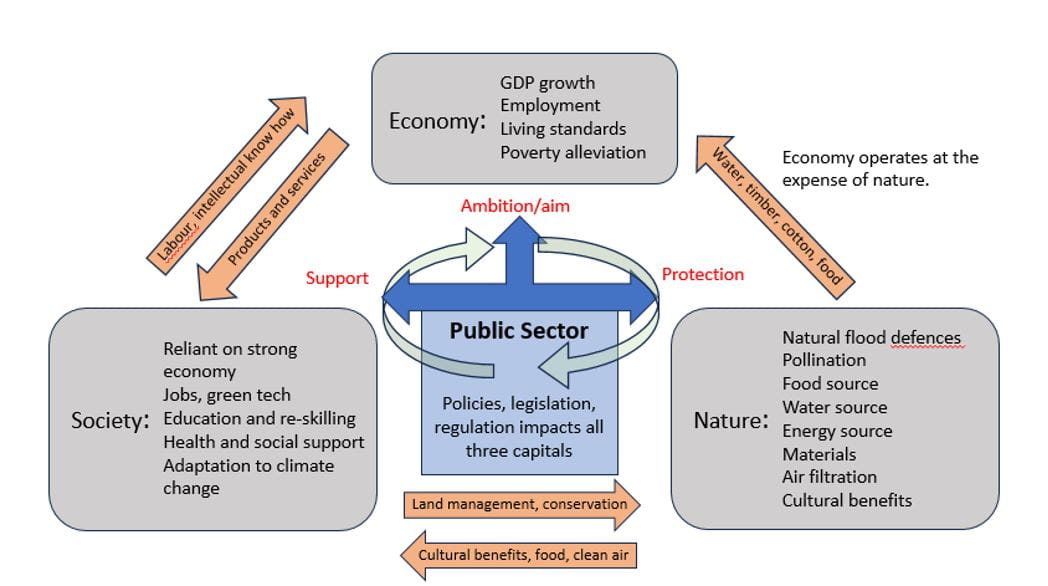
Who has responsibility/oversight of climate policy in the public sector?
As shown in the CO2 emissions by sector table above, transport is responsible for 32.5% of all emissions, followed by the energy sector at 25% and then business and residential buildings at 18.5% each. The public sector in the UK does not materially contribute to the CO2 emissions (2.4%).However, the public sector plays an instrumental role in setting the right policies to enable businesses and individuals to transition to net zero. Below is a table showing which central government departments have policy responsibilities for net zero.
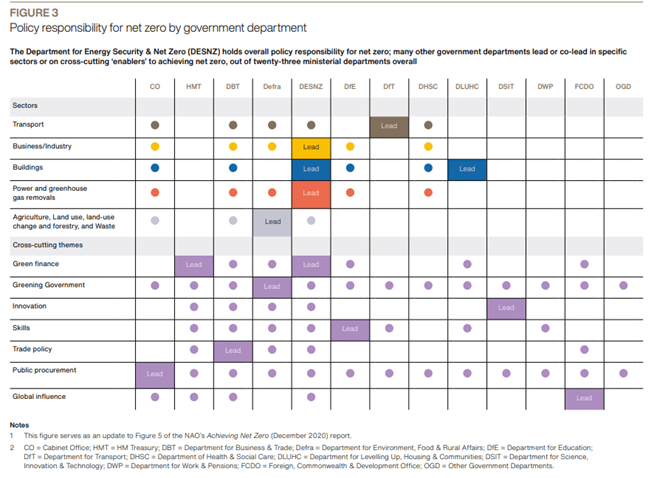
Source: Approaches to achieving net zero across the UK (nao.org.uk)
Some departments have key roles:
- The Department for Energy Security & Net Zero (DESNZ) has overall responsibility in government for achieving net zero and ensuring the whole of government works effectively to achieve it. It is also responsible for some of the highest-emitting sectors of the economy including buildings (alongside the Department for Levelling Up, Housing and Communities (DLUHC)), industrial decarbonisation and power.
- HM Treasury is responsible for allocating budgets to government departments and for fiscal policy.
- The Department for Transport (DfT) has responsibility for the decarbonisation plan of the UK’s highest-emitting sector of greenhouse gases (transport).
- Defra and DLUHC also have policy responsibility for different sectors of the economy with high emissions. DLUHC is the government’s steward of the local government system and should ensure that local authorities can function effectively. Local authorities themselves have a key role in supporting emissions reduction at a local level
- The Foreign, Commonwealth & Development Office (FCDO) works with other departments, and through its overseas network, to support and deliver the UK’s international climate and environment strategy.
Below are the 2023 priorities of DESNZ, DFT and Defra and whilst all mention climate and environmental priorities, they remain high level with poorly defined success measures such as ‘ensure is on track’. Using the budgeting framework, as described in more detail in the next section, could be an effective way to ensuring that climate remains a high priority of the relevant central government department.
DESNZ 2023 priorities:
1. Ensure security of energy supply this winter, next winter and in the longer-term – bringing down energy bills and reducing inflation.
2. Ensure the UK is on track to meet its legally binding Net Zero commitments and support economic growth by significantly speeding up delivery of network infrastructure and domestic energy production
3. Improve the energy efficiency of UK homes, businesses and public sector buildings to meet the 15% demand reduction ambition.
4. Deliver current schemes to support energy consumers with their bills and develop options for long-term reform to improve how the electricity market works for families and businesses.
5. Seize the economic benefits of Net Zero, including the jobs and growth created through investment in new green industries.
6. Pass the Energy Bill to support the emerging CCUS and hydrogen sectors; to update the governance of the energy system; and to reduce the time taken to consent offshore wind.
Department for Transport 2023 priorities:
1. Grow the economy by enhancing the transport network, on time and on budget
2. Improve transport users’ experience, ensuring that the network is safe, reliable, and inclusive
3. Reduce environmental impacts by tackling climate change and improving air quality by decarbonising transport
Defra 2023 priorities:
1. Improve the environment through cleaner air and water, minimised waste, and thriving plant and terrestrial and marine wildlife
2. Reduce greenhouse gas emissions and increase carbon storage in the agricultural, waste, peat and tree planting sectors to help deliver net zero
3. Reduce the likelihood and impact of flooding and coastal erosion on people, businesses, communities and the environment
4. Increase the sustainability, productivity and resilience of the agriculture, fishing, food and drink sectors, enhance biosecurity at the border and raise animal welfare standards
Government planning and performance framework
The government sets priorities, plans activity, allocates money and monitors its progress and performance using a collective set of processes as shown in the diagram below, known as the government’s planning and performance framework.
The government uses the budgeting system to consider all forms of public expenditure and sets strict budget limits that cannot be exceeded, known as Departmental Expenditure Limits (DEL).
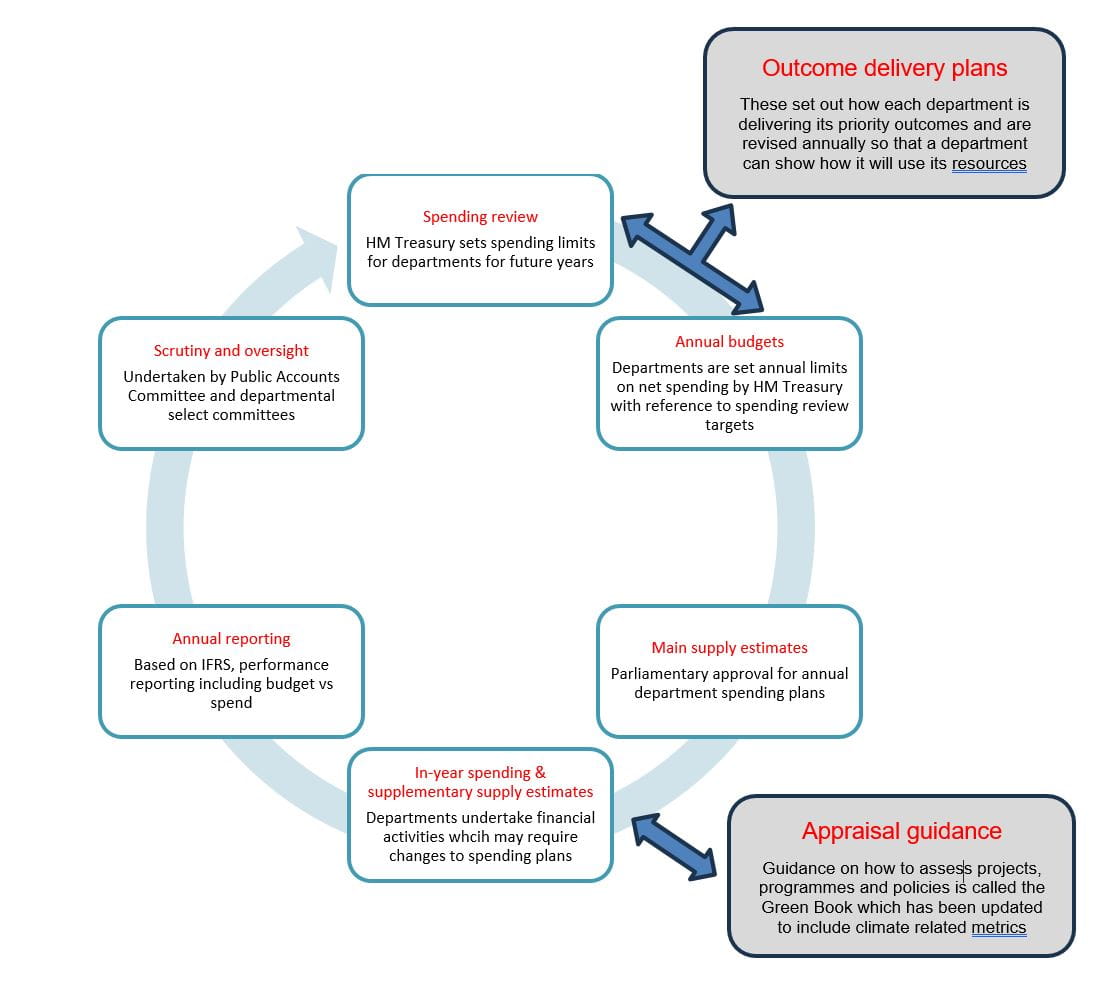
Further resources: The UK Central Government Public Financial Management System
Within the above framework, there is plenty of scope and opportunity to bring in climate considerations. For example, the UK government could adopt green budgeting to help achieve environmental goals which would include evaluating environmental impacts of budgetary and fiscal policies and assessing their coherence towards the delivery of national and international commitments.
This would be a balancing act since growing a consumption-based economy will at times be at odds with environmental targets but someone in government should have a complete overview to ensure high quality resource allocation that improves the economic prospects of the whole country without adding to climate change.
Current sustainability reporting frameworks
UK central government departments will be applying the TCFD model (Task Force on Climate-related Financial Disclosures) from 2023-24. The model is made up for four core parts and will be adopted on a phased basis as shown in the diagram below:
Governance: the organisations’ governance around climate-related risks and opportunities
Strategy: the actual and potential impacts of climate-related risks and opportunities
Risk Management: the process to identify, assess and manage climate-related risks
Metrics and Targets: to assess and manage relevant climate-related risks and opportunities
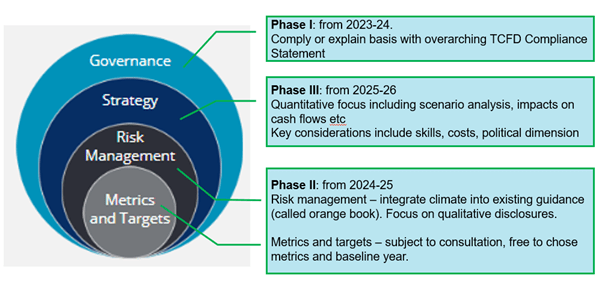
GGC reporting started in February 2011 to tackle carbon emissions and other climate related externalities. The programme is overseen by DEFRA with policy support from a number of other departments such as the Cabinet Office and HM Treasury.
The GGCs set out the targets that central government and their agencies must meet in five-year intervals. The first five-year period was from 2010 to 2015, followed by 2016 to 2020 and now the revised targets for 2021 to 2025 are in operation. Departments are evaluated against each of the following commitments:
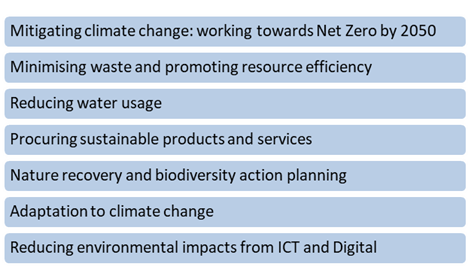
Conclusion
According to a Public Accounts Committee report from November 2022, there are a number of shortcomings that the government needs to address regarding the management, measurement and reporting of emissions for the public sector.
The report sets out a number of conclusions and recommendations, including:
- DESNZ (then BEIS) is not communicating progress on decarbonisation in the public sector clearly enough and does not hold individual departments to account.
- The public sector as a whole lacks clear standards for measuring and reporting emissions. This is primarily due to the fact that mandatory reporting guidance is for central government only; the NHS and local government are not in scope which is where the inconsistencies arise.
- Leadership and oversight of emissions measurement and reporting in central government is fragmented and ineffective. The report states that at least three departments are issuing guidance to central government on how to measure and report emissions, and these are inconsistent. DESNZ, HMT and Defra need to work together to consolidate, simplify and clarify current requirements.
- The Public Accounts Committee is not convinced that departments are making effective use of the emissions data to drive decision-making. The report notes that the £1.425bn within Phase 3 of the Public Sector Decarbonisation Scheme is on a first come first served basis rather than using the data to assess whether the funding is reaching the parts of the public sector and activities most in need. In theory, much of this funding should be allocated to the Department for Education given that it is responsible for 36% of all public sector building emissions.
Source: Written statements - Written questions, answers and statements - UK Parliament
